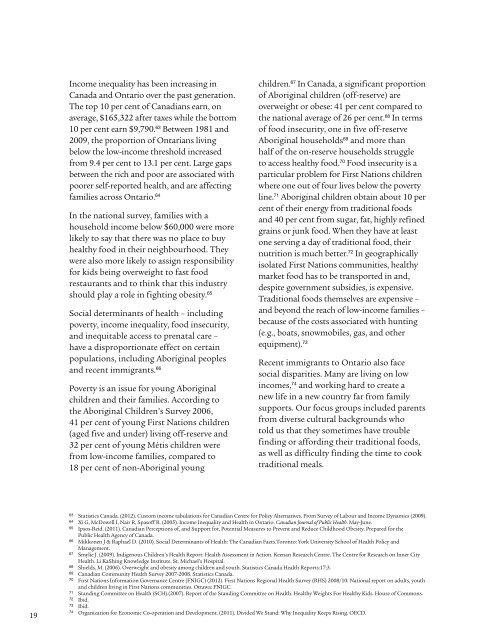No Time to Wait: The Health Kids Strategy - Ontario
No Time to Wait: The Health Kids Strategy - Ontario
No Time to Wait: The Health Kids Strategy - Ontario
- No tags were found...
You also want an ePaper? Increase the reach of your titles
YUMPU automatically turns print PDFs into web optimized ePapers that Google loves.
Income inequality has been increasing inCanada and <strong>Ontario</strong> over the past generation.<strong>The</strong> <strong>to</strong>p 10 per cent of Canadians earn, onaverage, $165,322 after taxes while the bot<strong>to</strong>m10 per cent earn $9,790. 63 Between 1981 and2009, the proportion of Ontarians livingbelow the low-income threshold increasedfrom 9.4 per cent <strong>to</strong> 13.1 per cent. Large gapsbetween the rich and poor are associated withpoorer self-reported health, and are affectingfamilies across <strong>Ontario</strong>. 64In the national survey, families with ahousehold income below $60,000 were morelikely <strong>to</strong> say that there was no place <strong>to</strong> buyhealthy food in their neighbourhood. <strong>The</strong>ywere also more likely <strong>to</strong> assign responsibilityfor kids being overweight <strong>to</strong> fast foodrestaurants and <strong>to</strong> think that this industryshould play a role in fighting obesity. 65Social determinants of health – includingpoverty, income inequality, food insecurity,and inequitable access <strong>to</strong> prenatal care –have a disproportionate effect on certainpopulations, including Aboriginal peoplesand recent immigrants. 66Poverty is an issue for young Aboriginalchildren and their families. According <strong>to</strong>the Aboriginal Children’s Survey 2006,41 per cent of young First Nations children(aged five and under) living off-reserve and32 per cent of young Métis children werefrom low-income families, compared <strong>to</strong>18 per cent of non-Aboriginal youngchildren. 67 In Canada, a significant proportionof Aboriginal children (off-reserve) areoverweight or obese: 41 per cent compared <strong>to</strong>the national average of 26 per cent. 68 In termsof food insecurity, one in five off-reserveAboriginal households 69 and more thanhalf of the on-reserve households struggle<strong>to</strong> access healthy food. 70 Food insecurity is aparticular problem for First Nations childrenwhere one out of four lives below the povertyline. 71 Aboriginal children obtain about 10 percent of their energy from traditional foodsand 40 per cent from sugar, fat, highly refinedgrains or junk food. When they have at leas<strong>to</strong>ne serving a day of traditional food, theirnutrition is much better. 72 In geographicallyisolated First Nations communities, healthymarket food has <strong>to</strong> be transported in and,despite government subsidies, is expensive.Traditional foods themselves are expensive –and beyond the reach of low-income families –because of the costs associated with hunting(e.g., boats, snowmobiles, gas, and otherequipment). 73Recent immigrants <strong>to</strong> <strong>Ontario</strong> also facesocial disparities. Many are living on lowincomes, 74 and working hard <strong>to</strong> create anew life in a new country far from familysupports. Our focus groups included parentsfrom diverse cultural backgrounds who<strong>to</strong>ld us that they sometimes have troublefinding or affording their traditional foods,as well as difficulty finding the time <strong>to</strong> cooktraditional meals.1963 Statistics Canada. (2012). Cus<strong>to</strong>m income tabulations for Canadian Centre for Policy Alternatives. From Survey of Labour and Income Dynamics (2009).64 Xi G, McDowell I, Nair R, Spasoff R. (2005). Income Inequality and <strong>Health</strong> in <strong>Ontario</strong>. Canadian Journal of Public <strong>Health</strong>. May-June.65 Ipsos-Reid. (2011). Canadian Perceptions of, and Support for, Potential Measures <strong>to</strong> Prevent and Reduce Childhood Obesity. Prepared for thePublic <strong>Health</strong> Agency of Canada.66 Mikkonen J & Raphael D. (2010). Social Determinants of <strong>Health</strong>: <strong>The</strong> Canadian Facts.Toron<strong>to</strong>: York University School of <strong>Health</strong> Policy andManagement.67 Smylie J. (2009). Indigenous Children’s <strong>Health</strong> Report: <strong>Health</strong> Assessment in Action. Keenan Research Centre. <strong>The</strong> Centre for Research on Inner City<strong>Health</strong>. Li KaShing Knowledge Institute. St. Michael’s Hospital.68 Shields, M. (2006). Overweight and obesity among children and youth. Statistics Canada <strong>Health</strong> Reports:17;3.69 Canadian Community <strong>Health</strong> Survey 2007-2008. Statistics Canada.70 First Nations Information Governance Centre (FNIGC) (2012). First Nations Regional <strong>Health</strong> Survey (RHS) 2008/10: National report on adults, youthand children living in First Nations communities. Ottawa: FNIGC.71 Standing Committee on <strong>Health</strong> (SCH).(2007). Report of the Standing Committee on <strong>Health</strong>. <strong>Health</strong>y Weights For <strong>Health</strong>y <strong>Kids</strong>. House of Commons.72 Ibid.73 Ibid.74 Organization for Economic Co-operation and Development. (2011). Divided We Stand: Why Inequality Keeps Rising. OECD.
















